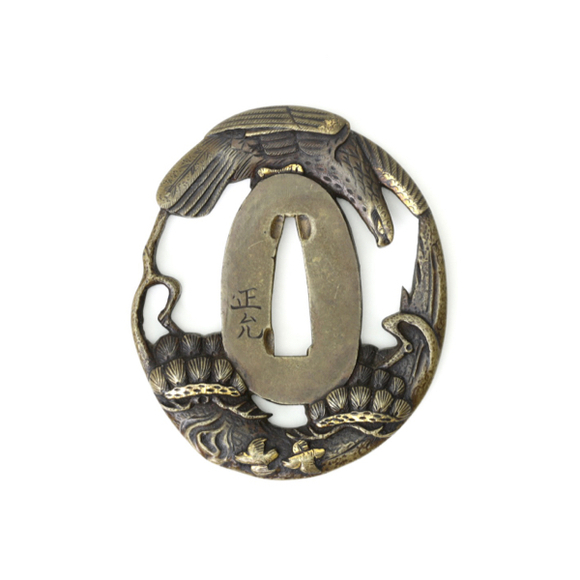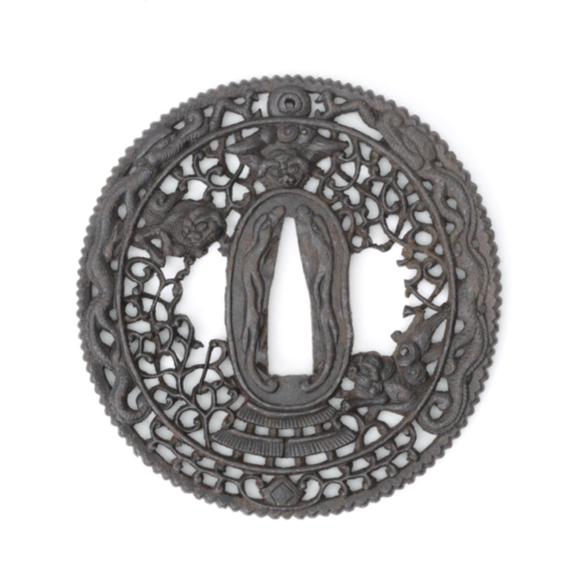Language: Japanese
Source: 武器皕圖 (Buki Nihyaku Zu) of 1848
Description
The kankyûtô, written 貫級刀 or 貫首刀 in Japanese, is a small tool with a double-edged tip, made of a single piece of steel. that could be worn in the scabbard of a sword instead of a kozuka.1
Their original use was associated with the practice of cutting enemy heads and presenting them with a tag, a practice that continued into the Muromachi period (1336-1573). Theories vary about whether it was used to affix the tag, or having to do with adding a thread to a head for mounting or transport.2

A typical late Edo period kankyûtô.
Mandarin Mansion stock 2021.
The design dates back to at least the 11th century but most of them encountered today are from the Edo period.3
Engravings
These late versions commonly have chiseled in their blades the 16-petal Chrysanthemum mon, the imperial logo, and the words: 雷除 “kaminari-yoke", a talisman against thunder and fire. As such, they were probably carried as talismans.
On their hilts are two lines of poetry. The character used differ a little from piece to piece, but are generally something like:
豈好多臓王家御侮𡺉功載
成名冓古干墓千佩粛御厥武
My loose translation:
How can it be, that insults that went back and forth from the insides of royal houses, caused many to be carried [away].
They made a name [for themselves] in the chambers of palaces, [but are] now in tombs. Thousandfold respect for the fallen soldiers.
Possible origins of the late Edo version
In his article, Mike Vinehout suggests that Daimyo Matsudaira Sadanobu (1759-1829 A.D.) had these reproduced by the notable smith Tegarayama Masashige, based on an older piece that was attributed to Minamoto Hachimantaro Yoshiie (1039-1106 A.D.), a notable Heian period samurai. He believes that the wearing of them during the Edo period, long after the tradition of collecting enemy heads ended, was probably an act of nostalgia.4
According to Jacques van As, however, the first of these were produced by 5th generation Iga no Kami Fujiwara Kinmichi from the Mishina school, who had the right to use the 16-petal imperial mon. Copies, even by lesser smiths, kept incorporating the mon so it looked more like Kinmichi's work.5
There is an example in a Dutch collection signed on the blade:
”駿州住人盛重“
Sunshū jūnin Morishige
"Morishige, resident of Sunshū province"
Other double-edged tools
The kankyûtô looks much like the bashin (馬針) or "horse needle", a horse bloodletting tool. The same characters can also be pronounced umbari which is generally used to describe the same tool, but with a longer blade. Both bashin and umbari are usually not of one-piece construction and lack the hole at the end that kankyûtô always have. According to Markus Sesko, bashin became part of Higo-koshirae (Higo-style sword mounts).6
Notes
1. The 武器皕圖 (Buki Nihyaku Zu) by Yu Kobayashi, 1848, illustrates one of these and gives the name 貫級刀.
2. Mike Vinehout, assisted by Markus Sesko and Dr. Chris Leung; The Rituals of Victory. Japanese Sword Society of the United States Journal, 2014.
3. Ibid.
4. Ibid.
5. Jacques van As; Mamori-gatana en yomeiri-tantō. Wapenfeiten Nummer 3, September 2021.
6. Ibid. and Markus Sesko; Encyclopedia of Japanese Swords. Lulu, 2014. Page 23.






